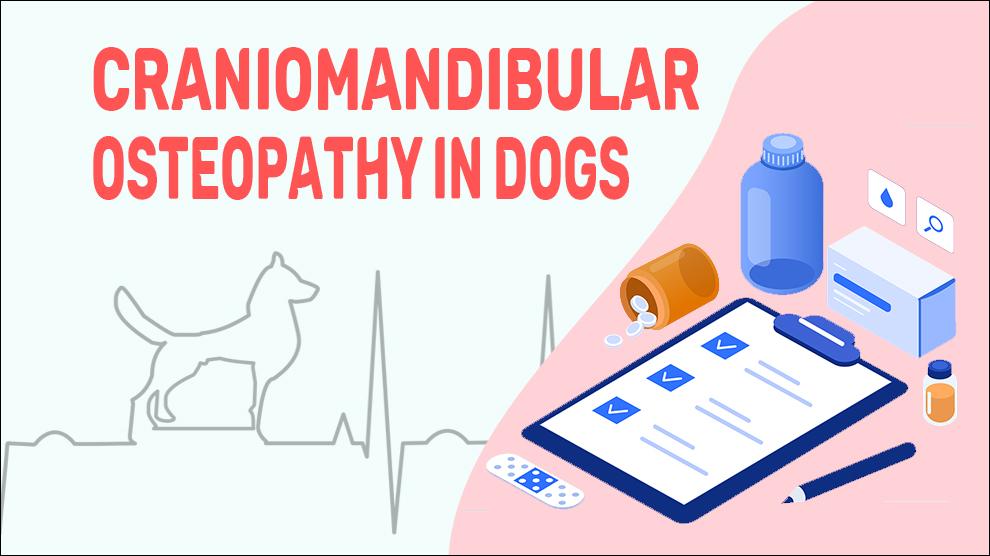Craniomandibular Osteopathy (CMO) is a rare, autosomally recessive inherited, non-inflammatory, progressive, degenerative disease of the cranial bones (bones of the jaw and skull) in dogs. The incidence has not been established exactly, but luckily, the condition is self-limiting. That is to say, the bone growth ceases or even regresses and the dogs "grow out of it” as the symptoms usually resolve by one year of age.
Also referred to as "lion jaw", "temporomandibular osteodystrophy" and "mandibular periostitis," - this is a result of swelling of bones during the growth of head and jaw bones.
The dense osseous proliferation from the affected periosteal surfaces is often bilateral, though unilateral conditions can happen. Bony proliferation can affect jaw movement and can involve the TMJ.
Craniomandibular Osteopathy is described as largely idiopathic, as it is not caused by any existing disease. craniomandibular osteopathy clinical signs are similar to Calvarial hyperostosis syndrome (CHS) and human infantile cortical hyperostosis (Caffey disease), however, the differential diagnosis is done by its proliferative nature and unusual asymmetric skull bone manifestation.
Symptoms Of Craniomandibular Osteopathy
- Painful swelling of skull bones.
- Swelling of jaw bones.
- Difficulty picking up food with the mouth.
- Bulging eyes
- Fever and fatigue
Treatment Options For Craniomandibular Osteopathy
It is important to understand that for the treatment of CMO in dogs the focus is management rather than cure. Success in treatment means minimizing pain while maximizing your dog's comfort and function.
- Bone Growth Optimization: Limiting food consumption and avoiding calcium supplementation.
- Maintaining Healthy Weight: Noticeably decreases the rate of OA progression in dogs.
- Pain Management:
- Nonsteroidal anti-inflammatory drugs (NSAIDs).
- Nutritional supplementation - Omega-3 fatty acids and undenatured collagen.
- Anti-inflammatories
- Amantadine - brand names - Gocovri, Osmolex ER, Symmetrel and Endantadine.
Home Remedies For Craniomandibular Osteopathy
Craniomandibular osteopathy is a condition that is not improved by conservative treatment. So treatment is rarely recommended. Discuss with a veterinarian any home care specific to your dog’s situation.
Prevention Of Craniomandibular Osteopathy
CMO etiology is poorly understood. Prevention is not possible for CMO as the causes in dogs is varied. Hereditary is a factor in some breeds and there’s not much a pet parent can do to prevent them, but a high-quality diet with antioxidant supplements may help in one way or another.
Consult with a veterinary orthopedic to know what is the proper diet for your dog’s bones and its overall health.
Affected Breeds Of Craniomandibular Osteopathy
West Highland White Terrier, Terrier Dog Breeds, Puppies, Cairn Terrier, Bullmastiff, Boston Terrier, Labrador Retriever, Doberman Pinscher, English Bulldog, Shetland Sheepdog, Irish Setter
Additional Facts For Craniomandibular Osteopathy
- Causes:
- Genetics
- The mode of inheritance is autosomal recessive.
- Irrespective of the possibility of bacterial or viral involvement in non-terrier breeds, it's widely held that this condition is of genetic origin.
- Morbidity:
The asymmetrical, periosteal proliferation of the bones of the skull and jaw in all young dogs can be considered CMO. Meanwhile, Calvarial hyperostosis syndrome (CHS) is also a non-inflammatory, benign, progressive bone disease of the flat bones of the skull.
The location of the lesion is of great significance for the differential diagnosis of CMO and CHS.
CHS does not seem to affect the medullary cavity. The CHS lesion is focal, localized (sub) periodically, unilateral and there is no involvement of the mandible.
- Mortality:
There is no evidence of CMO alone affecting the life span.
- Diagnosis:
- X-ray of the jaw.
- Blood tests to rule out infection.
- Prognosis:
The prognosis depends on the severity of proliferation of bones at the temporomandibular joints (TMJs), the tympanic bullae, and angular processes. The prognosis for radiographic evidence of complete or partial bony ankylosis of the TMJs and/ or excessive bony proliferation of the bullae as well as the mandible is poor.
When To See A Vet
Contact your vet right away, if you notice any of the following:
- Painful swelling of skull bones.
- Swelling of jaw bones.
Food Suggestions For Craniomandibular Osteopathy
Foods to avoid:
- Grains: Rice, Wheat, Soy, etc.
- Corn
- Commercial diet (kibble and/or canned food).
- Avoid fatty proteins (go for lean proteins).
- Treats, Table scraps, Added Salts, Sugars, and Artificial Additives.
Foods to feed:
- Bland diet: Boiled chicken, cooked rice, tofu, low-fat cottage cheese, boiled hamburger, canned tuna, etc.
- Semi-moist pet food with boiled chicken or Meat-flavored baby food.
- Leafy greens: Spinach, Lettuce, Kale, and Green beans.
- Fatty fish: Salmon, Tuna, Sardines, Mackerel, etc.
- Lean protein: Chicken, Turkey.
- Antioxidant-packed fruits: Cherries, Blueberries, Peeled apple, Cantaloupe.
Conclusion
When your dog's skull has asymmetric swellings, a trip to the vet may not be necessary.
Head to the vet only if: The swelling gets worse.
Although the condition is usually self-limiting and benign, it is always good to get the opinion of a veterinary neurologist. There are no reported behavioral or neurological problems.

















